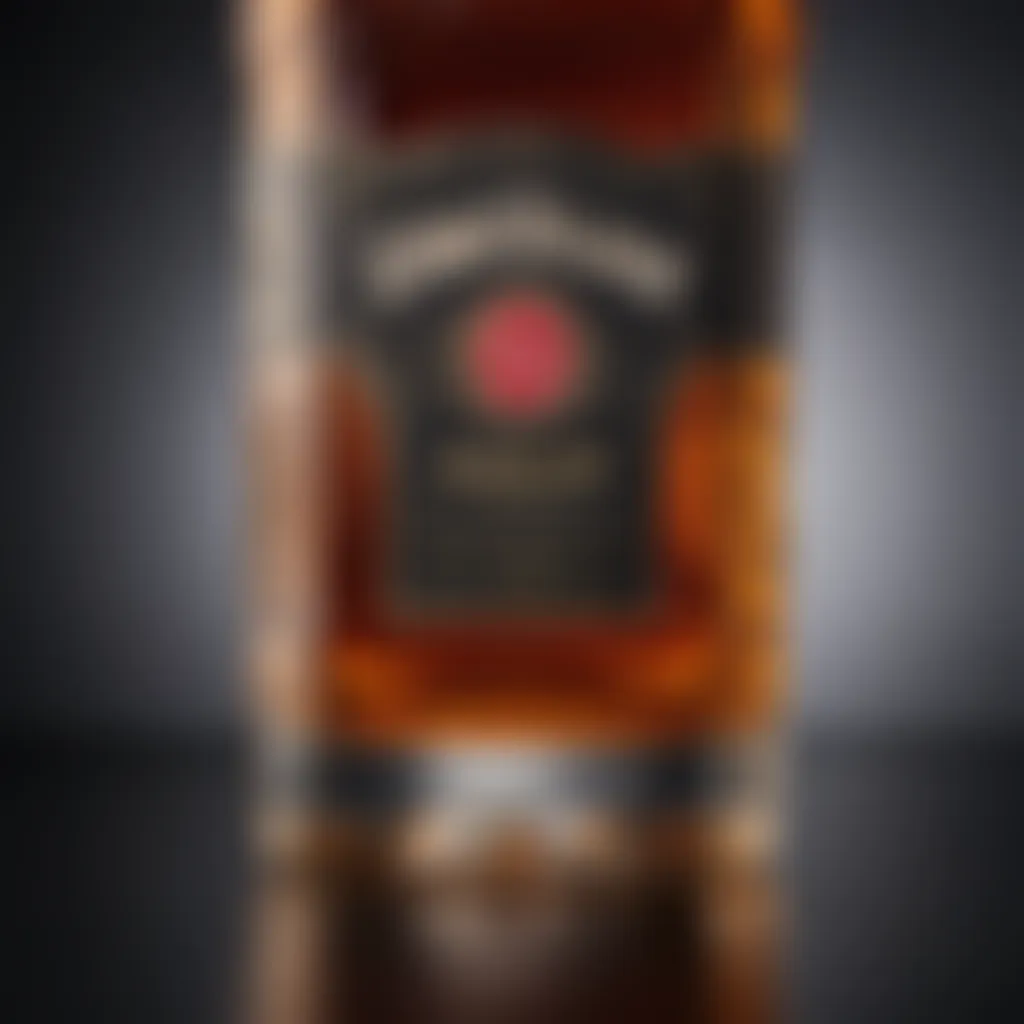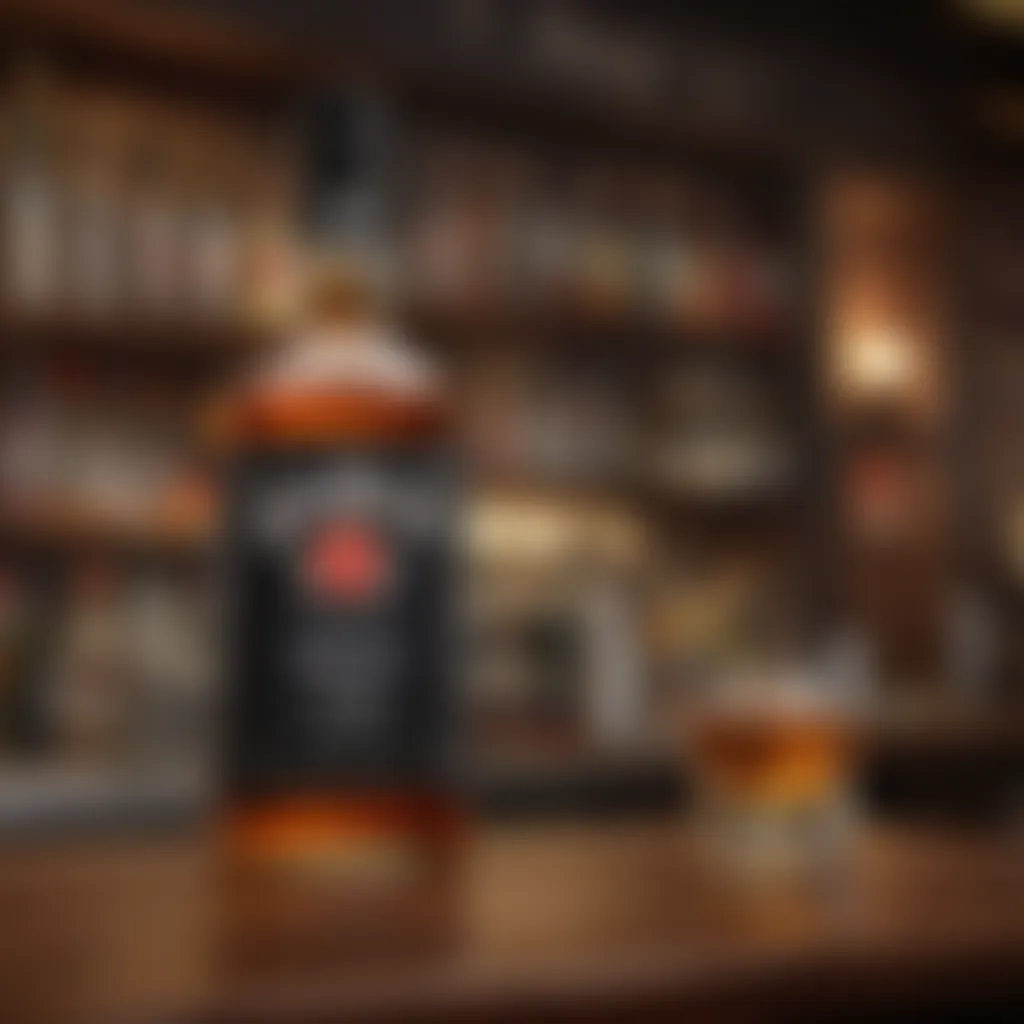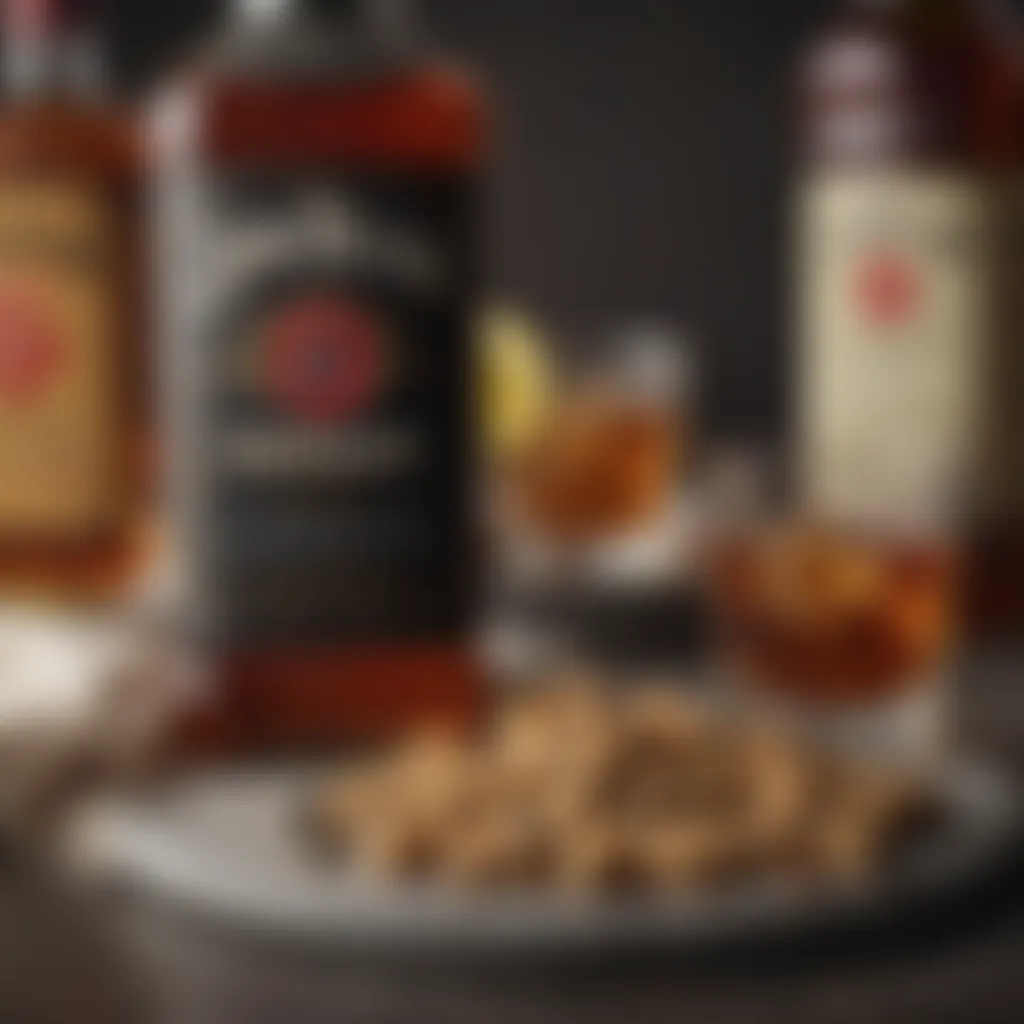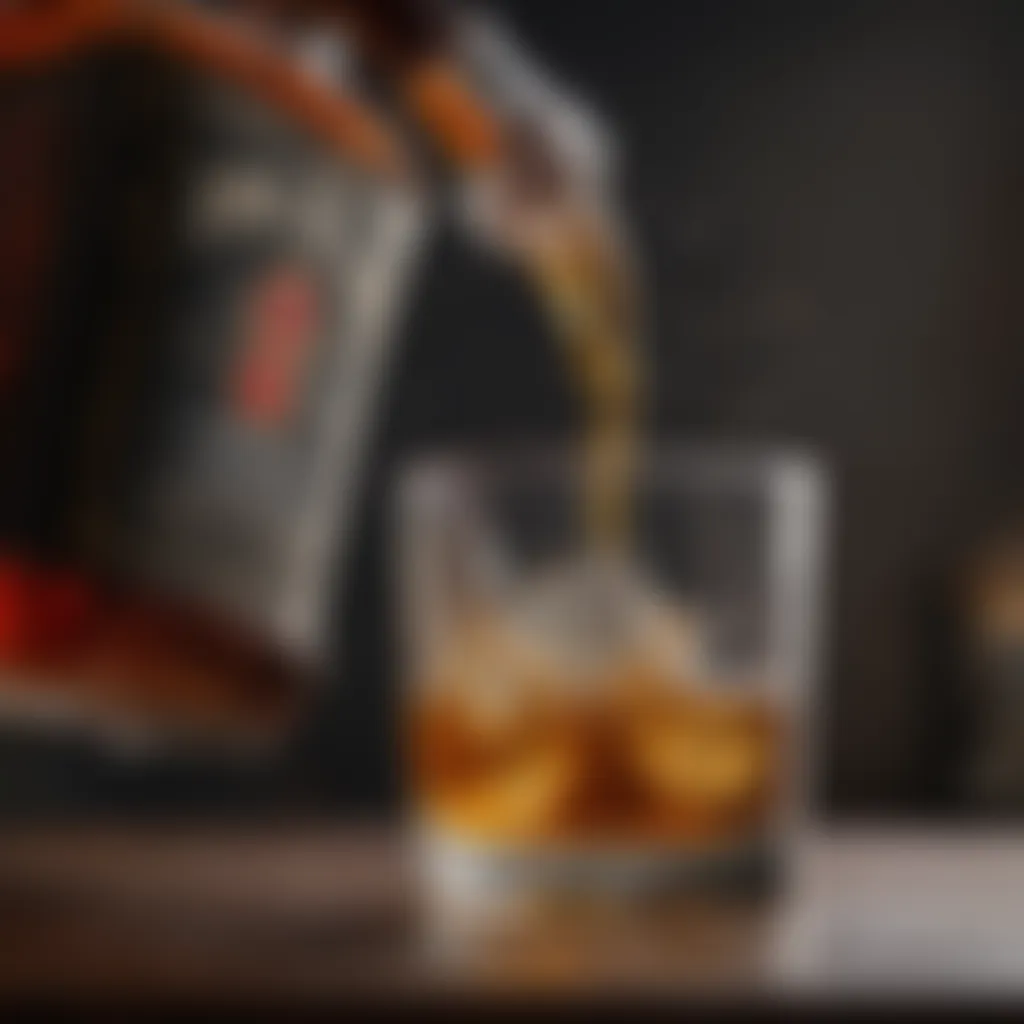Understanding Jim Beam's Caloric Impact on Health


Intro
In the realm of beverages, few spirits command the attention that Jim Beam whiskey does. A staple in many homes, it carries with it a rich heritage intertwining craftsmanship and flavor. However, for those conscious about their dietary intake, understanding the caloric content of Jim Beam is crucial. While seeking that delightful taste, one must also consider how each pour aligns or clashes with personal health goals. In this article, we’ll peel back the layers of whiskey consumption, particularly focusing on Jim Beam, and how its caloric content can impact the lifestyle choices of the modern housewife.
As we dissect the nutritional components, we'll wander into discussions about serving sizes, responsible drinking, and the myriad effects these liquors can have on overall well-being. By the end, it should be clearer how to enjoy Jim Beam in a way that harmonizes both pleasure and health.
Caloric Overview of Spirits
Understanding the caloric content of spirits is crucial, especially in today's health-conscious world. When it comes to beverages, spirits can have a significant impact on an individual’s caloric intake. This article aims to unravel the complexities of caloric consumption from spirits like Jim Beam, which holds a prominent place in many people's drinking experiences.
The primary focus is to guide readers through how whiskey stacks up against other liquors, helping to make informed choices that align with dietary goals. With the casual consumption of whiskey becoming a modern norm, grasping the caloric implications cannot be understated. Tuning into this topic sheds light not only on personal health but also encourages responsible drinking habits.
Understanding Calories in Alcohol
Calories in alcohol mainly come from its alcohol content itself. Each gram of alcohol has about seven calories, which might not sound like much, but when you consider how quickly drinks can add up, it becomes apparent. Unlike carbohydrates or protein, alcohol does not provide any nutritional value. Instead, it becomes a source of empty calories that can easily sneak into one’s diet unnoticed. For anyone keeping a keen eye on their caloric consumption, recognizing these empty calories is key.
Notably, whiskey, like Jim Beam, tends to be lower in calories compared to mixed drinks which often contain high-sugar mixers. A straight pour or a drink with ice allows you to enjoy the flavors without the added sugars that can intensify caloric intake.
Comparative Analysis of Caloric Content
In the world of spirits, a comparison between whiskey, wine, and beer reveals vital insights about their caloric profiles. Understanding these differences aids in making mindful choices concerning alcohol consumption. Let's take a closer look at each category:
Whiskey vs. Other Spirits
Whiskey can often be a more favorable choice for those counting calories. A standard shot of James Beam contains about 70 calories, which is lower than many other spirits like rum or gin when consumed straight. The distilled nature of whiskey often results in fewer additives and sugars, which is why it ranks pretty good on the caloric scale. If you're leaning towards simplicity and flavor, opting for whiskey might just save you some unwanted calories.
Whiskey vs. Wine
When pitted against wine, whiskey can still hold its own in the caloric department. A glass of wine averages between 120-130 calories. By comparison, a whiskey neat barely tips the scales at around 70 calories. Despite whiskey not having the same health reputation as red wine—which is often touted for its antioxidant properties—it provides a less caloric alternative. The trick, however, is to enjoy whiskey without high-calorie mixers to truly appreciate its lower caloric benefit.
Whiskey vs. Beer
Beer poses a different challenge in the caloric calculation. An average beer can range from 150 to 200 calories per serving, depending on the type. Here, whiskey again shows an advantage. A shot of Jim Beam provides a richer flavor and occupies fewer calories than a typical bottle of beer. So, if you’re looking to indulge but wary of the caloric hit, reaching for whiskey could help you sidestep the calorie-laden world of beer.
By comparing whiskey with other types of spirits and alcoholic beverages, it becomes clear that it can be a smart choice for those looking to minimize caloric intake while still enjoying their drink of preference. As we dive deeper into the implications of these caloric details, we'll discover how Jim Beam not only fits into this conversation but also plays a role in informed drinking choices.
Jim Beam: A Historical Perspective
When looking at the caloric content of Jim Beam and its implications for health, it becomes crucial to understand the historical landscape of this iconic brand. The narrative behind Jim Beam transcends mere production; it is intertwined with the evolution of American whiskey itself. Understanding the rich past of Jim Beam provides context not only for its current standing but also illuminates consumer choices today, particularly regarding caloric intake from spirits.
Understanding history offers numerous benefits. For one, it allows consumers to appreciate the craftsmanship that goes into making this bourbon. It also sheds light on shifts in consumption patterns, aligning them with changing societal values. An informed consumer is more likely to make choices that reflect their lifestyle goals, especially when facing dietary needs.
Origins of Jim Beam
Jim Beam has its roots planted firmly in the early 18th century, with Jacob Beam being one of the first to distill in the area now known as Kentucky. The year was 1795 when Beam began his journey, producing a whiskey that eventually gained popularity. This pioneering spirit was born out of necessity and innovation, as early distillers sought to create a product that could withstand time and weather.


Over the years, Beam family members continued this tradition, passing it down through generations. The historical footprint of Jim Beam isn't just about the whiskey, but also about the resilience of the Beam family. They faced challenges, such as Prohibition, which could have derailed many operations. Instead, they adapted and survived, ensuring that the brand was ready to flourish once more.
Evolution of the Brand
The evolution of Jim Beam as a brand is fascinating. By the time the 20th century rolled around, Jim Beam had established itself as a staple in whiskey production. The company's marketing savvy and adaptability allowed it to thrive. They not only focused on distillation quality but also began offering a variety of products, which appealed to a broader audience.
In the 1960s and beyond, Jim Beam recognized societal shifts toward less drinking during meals and more social drinking occasions. They introduced various expressions like Jim Beam Black and Jim Beam Devil's Cut to accommodate advancing tastes and preferences.
The tagline of "Jim Beam: It’s not just bourbon; it’s an experience” reflects the brand’s ambition to establish an emotional connection with its consumers. As whiskey culture has surged in popularity, Jim Beam has positioned itself strategically to engage with new drinkers while retaining the loyalty of traditional whiskey aficionados.
As it stands today, Jim Beam is not only about the spirit itself but also about the values and the legacy it represents. The brand's historical context shapes how one perceives its caloric content; recognizing its rich background enhances our understanding of moderation, enjoyment, and the balance it encompasses.
Caloric Breakdown of Jim Beam
Understanding the caloric breakdown of Jim Beam whiskey is crucial for anyone who enjoys this spirit. With an ever-growing awareness about health and diet, it's important to know how each drink stacks up against your overall caloric goals and lifestyle choices. Whiskey, particularly one as iconic as Jim Beam, comes with its own set of nutritional considerations, which can influence both casual drinkers and those more health-conscious.
Calories per Serving
When enjoying a glass of Jim Beam, it's essential to consider how many calories you’re possibly consuming. On average, a standard serving of Jim Beam, roughly 1.5 ounces, contains around 97 calories. This calorie count can vary slightly depending on the specific variety of Jim Beam, such as their Bourbon or flavored options like Apple or Honey. Understanding this number can be quite pivotal, particularly when you factor in your daily caloric intake.
- With mixers: Many folks enjoy whiskey mixed with ginger ale or cola. This choice can significantly bump up the calorie count, so be mindful of the mixer used.
- Sipping straight: Enjoying it neat or on the rocks reduces the overall caloric intake since you’re avoiding the extra sugars from mixers.
If you consider whiskey part of your regular diet, you may want to keep a tally of how these calories affect your food choices throughout the day.
"A drink that seems harmless can easily fit into a heavy calorie count, turning a night of fun into a day of regret!"
Understanding Alcohol Content and Calories
Alcohol content is a major component when discussing calories in beverages. The relationship between alcohol content and caloric intake is not as straightforward as it may seem. Jim Beam whiskey has an alcohol content of about 40% ABV (alcohol by volume). This percentage means that for every 100 milliliters of whiskey, 40 milliliters is pure alcohol.
- Why is this important? Each gram of alcohol contains 7 calories, much higher than carbohydrates or proteins, which clock in at 4 calories per gram. That means the alcohol itself contributes significantly to the total calorie count in your drink.
- Further implications: When choosing to indulge, knowing the alcohol level can give you a clearer picture of how it fits into your dietary framework. Overconsumption not only racks up calories but can also lead to unintended weight gain over time.
In summary, grasping the caloric breakdown of Jim Beam opens the door to informed decisions. It helps in recognizing the impact of alcohol on your daily caloric goals. Encouraging a balance between enjoyment and health is key to a well-rounded lifestyle.
Implications of Caloric Intake
When discussing the caloric content of Jim Beam whiskey, understanding the implications of those calories is paramount. This section serves as a critical exploration of how the consumption of alcohol affects one's diet and health in general. As the discussion moves forward, it will become clear that every sip has its consequences, both seen and unseen. This is particularly important for individuals who are not just enjoying the drink but also keeping an eye on their overall health and well-being.
Effects on Weight Management
The relationship between alcohol calories and weight management is intricate. For starters, it's essential to recognize that alcoholic beverages, including Jim Beam, contribute towards your daily caloric intake without necessarily fulfilling nutritional needs. Simply put, a glass might taste good, but it often doesn’t translate into nutritional value.
- Caloric Surplus: If someone regularly consumes more calories than they expend, weight gain is bound to happen. For example, if a serving of Jim Beam, typically around 100 calories, becomes a daily habit, it can easily pile up alongside meals that may already be high in calories.
- Nutritional Displacement: One often overlooked aspect is that indulging in whiskey can lead to less healthy food choices. Parents might opt for a light snack instead of a nutritious meal after having a drink. This displacement of wholesome foods can undermine dietary goals.
To truly manage weight effectively, it is advised to consider alcohol not as part of a meal but as an addition that requires careful calculation. Monitoring one’s caloric intake, while enjoying Jim Beam in moderation, can contribute to maintaining a balanced diet.


Alcohol's Role in Overall Caloric Consumption
When considering alcohol like Jim Beam, the broader context of overall caloric consumption comes into play. Alcohol is unique in that it provides 'empty calories'—calories that offer little to no nutritional benefit. This means they can accumulate quickly and quietly in our diet without us being fully aware of it.
"It's the hidden calories that can sneak up on you, especially when sipping leisurely at a gathering or unwinding after a long day."
- Social Context: At gatherings or festive occasions, combined drinks can escalate Wisely mixing spirits like Jim Beam with sugary mixers can double the caloric intake without realizing it. Being mindful of mixers used is just as important as the spirits themselves.
- Post-Consumption Choices: After drinking, cravings can increase—often leading to poor food choices. Just imagine skipping the healthy salad for a calorie-laden snack simply because of those whiskey calories!
- Cognitive Effects: Alcohol can reduce the ability to make healthy choices. This loss of willpower can be especially detrimental when combined with evenings out or celebrations, which naturally encourage indulging.
In summary, Jim Beam brings its own caloric baggage. Making informed choices about when and how much to drink can help keep the scale in check and support overall health goals. Being aware of these implications allows for more responsible consumption and better health management.
Health Considerations Related to Caloric Content
When we discuss Jim Beam whiskey and its caloric content, it's essential to recognize the health implications intertwined within alcohol consumption. Many people think of whiskey purely as a recreational beverage, but it's so much more. Understanding the calories in a glass of Jim Beam and their potential effects on both body and mind can be eye-opening, especially for those aiming to maintain a balanced lifestyle. This exploration is not just about numbers; it’s about wellbeing, choices, and the delicate balance between enjoyment and moderation.
Recognizing Moderate Consumption
Moderate consumption is often touted as a key principle in enjoying alcohol while minimizing health risks. For whiskey enthusiasts or anyone enjoying Jim Beam, moderation typically means sticking to about one drink per day for women and up to two for men. But what constitutes a "drink"? For whiskey, one serving is about 1.5 ounces, which can be both enlightening and misleading since the serving size may seem small but carries significant caloric weight.
Understanding the caloric contribution of Jam Beam – roughly 100 calories per serving – is crucial. This means that if one is not paying attention, simply enjoying a few drams can lead to a quick accumulation of calories. Balancing that with your daily energy intake and nutritional goals is vital.
Consider this: If a housewife enjoys a glass of Jim Beam after a long day, it could impact her total calorie consumption. If she’s also snacking or having dinner, she might want to think carefully about how her drink fits into her day. Here’s a quick rundown:
- Calories Add Up: Two servings could translate to 200 calories that might tip over her daily limit.
- Hunger Signals: Alcohol can modify hunger signals, often leading to cravings for high-calorie foods, making moderation even more essential.
- Emotional Associations: Many people associate drinking with relaxation, but it’s necessary to ensure it doesn’t become a crutch for stress relief.
Assessing Risks of Excessive Drinking
On the other side of the coin lies the issue of excessive drinking. While Jim Beam can be appreciated responsibly, overindulgence can bring a slew of health risks. For instance, regularly exceeding moderate consumption can lead to a long list of consequences that range from the mildly concerning to the severe.
Firstly, the caloric content is only a part of the story. Overshooting the daily recommended alcohol intake can lead to weight gain, digestive problems, or even chronic conditions over time. Here’s how:
- Weight Gain: Alcohol contains empty calories – they provide energy with little to no nutritional benefit. That excess ultimately gets stored as fat, especially if exercise is minimal.
- Liver Health: Too much can stress the liver. This organ plays a vital role in metabolizing alcohol, and consistently overdoing it may result in fatty liver disease or worse.
- Mental and Emotional State: Excessive drinking can lead to mood swings, anxiety, or depression, all of which can be exacerbated by the heavy caloric weight over time.
- Social Considerations: Drinking more than intended can lead to poor decision-making in social settings, which can further complicate health issues and dietary choices.
In sum, while enjoying Jim Beam, it's vital folks keep moderation in mind and understand how to assess the risks tied with excessive drinking. Education is the first step toward making informed decisions, ensuring that health remains a priority while savoring each sip.
"A little knowledge is a dangerous thing; drink deep, or taste not the Pierian spring."
Ultimately, the exploration of Jim Beam’s caloric content and its broader health implications equips consumers with perspective, allowing them to enjoy their favorite whiskey without compromising their health goals.
Cultural Attitudes Towards Whiskey Consumption
Cultural attitudes towards whiskey consumption can be as diverse and rich as the spirit itself. It impacts not only how whiskey is perceived, but also how it is integrated into various social structures and personal lifestyles. Understanding these cultural nuances is essential, especially for those who enjoy beverages like Jim Beam. The interplay between tradition, enjoyment, and health awareness helps inform our choices surrounding whiskey consumption.
Historical Significance of Whiskey
The roots of whiskey run deep, intertwined with centuries of tradition. In many cultures, whiskey drinks have become synonymous with celebrations and gatherings. It’s a common sight in toasts at weddings, baptisms, and even formal dinners. In the United States, bourbon whiskey, with Jim Beam being a prime example, tells a story of craftsmanship and heritage.


Take the Prohibition Era, for instance. During this time, whiskey consumption either went underground or was significantly altered. People became more resourceful, smuggling in what they could get their hands on. The allure of whiskey grew, turning it into more than just a drink—it became a symbol of resistance and freedom for many.
Whiskey’s historical significance also embodies the concept of community. Whether seen during a family gathering or a night out, it fosters connections. People gather around bottles of Jim Beam, sharing stories and pouring over memories. It serves as a cultural lynchpin, knitting together generations.
Modern Trends in Whiskey Consumption
Fast forward to today, the way whiskey is enjoyed has evolved dramatically. No longer just a drink for special occasions, whiskey has found its place in casual settings. This shift brings new dimensions to the appreciation of whiskey, especially among younger drinkers.
The fondness for crafting unique cocktails has made whiskey a versatile player. The modern mixologist often experiments with Jim Beam in various delightful concoctions, balancing flavors and textures, which invites an exploration of taste. Even at home, many are now keen to whip up a whiskey-based drink, creating a personal touch in their enjoyment.
- With the rise of social media, whiskey culture is rapidly gaining visibility. Enthusiasts share their tasting notes or cocktail creations on platforms like Reddit and Facebook, further broadening the conversation about whiskey.
- Moreover, sustainability has become a focus in whiskey production. Consumers are increasingly eager to know where their spirits come from, seeking brands that champion responsible sourcing and environmental stewardship.
Practical Considerations for Consumers
Understanding what you are consuming when it comes to alcohol is vital, especially with a product like Jim Beam whiskey. Whiskey isn't just a drink; it's part of a lifestyle for many. People enjoy sipping it neat, mixing it in cocktails, or even using it as a cooking ingredient. Thus, some practical considerations can help consumers make informed choices about their whiskey consumption.
Selecting Quality Brands
When looking at brands, it's essential to remember that not all whiskeys are made equal. Jim Beam stands out for its quality, but there are several facets to consider when selecting whiskey:
- Ingredients Matter: Quality ingredients can make the difference between a mediocre whiskey and a splendid one. Jim Beam uses corn, rye, and malted barley that contribute to its smooth profile.
- Reputation and History: The tradition of a brand often reflects its quality. Jim Beam has been making whiskey for generations, offering a trusted craft that many appreciate.
- Production Methods: Pay attention to how whiskey is made. The distillation process, barrel aging, and even the water source can influence the final product. Jim Beam follows strict guidelines that honor traditional bourbon-making techniques.
Don't hesitate to do some research on brands. It can be as simple as checking reviews online. Sites like reddit.com can provide insights from everyday consumers about their favorites.
Informed Drinking Choices
Being informed goes hand in hand with enjoying your drink mindfully. Understanding how to incorporate Jim Beam into your lifestyle can be a game-changer. Here are a few tips to keep in mind:
- Know Your Servings: A standard serving of whiskey is typically 1.5 oz. But if you’re pouring a heavy hand, keep track of how it impacts your caloric intake. Jim Beam clocks in around 97 calories per serving, so it can add up quickly if you’re not careful.
- Mixing Wisely: If you're a fan of cocktails, think about how mixers impact the overall caloric load. Juices, sodas, or simple syrups can dramatically increase calories. Opt for calorie-friendly mixers or consider straight shots of Jim Beam instead.
- Set Limits: Understanding when to say no is crucial. The social aspects of drinking can sometimes lead to overindulgence. Setting a personal limit can help maintain your lifestyle goals without sacrificing enjoyment.
"Moderation is key. One can savor whiskey without overdoing it."
By adopting these practical considerations, consumers can enjoy whiskey while also staying aware of the choices they are making. It's about balance, being informed, and enjoying each sip of that amber delight mindfully.
The Future of Whiskey and Health Awareness
As the conversation around alcohol consumption grows, it's becoming increasingly important to evaluate how whiskey fits into our health landscape. The future of whiskey is not just about the flavors or brands; it carries implications for our wellness, habits, and public perception. This section aims to outline these connections and their relevance to today's health-conscious consumers.
Emerging Research on Alcohol Consumption
Recent studies have begun to unpack the complexities of alcohol and its effects on the human body. Increased scrutiny on the connection between alcohol and health outcomes sheds light on some surprising angles. For instance, researchers are looking at not just the immediate effects of whiskey on our systems but also the long-term health impacts, particularly dosage and frequency of consumption. With the trend leaning towards moderation rather than outright abstinence, insights into how different types of alcohol affect various demographics have emerged.
- Caloric Impact: Understanding the caloric value within whiskey, such as that found in Jim Beam, is crucial. Varied research outputs suggest that while moderate drinking can fit within a balanced diet, excess consumption leads to excessive caloric intake which can be counterproductive.
- Metabolic Studies: Investigations are also underway about how the body metabolizes different alcohol types. Whiskey may influence metabolic rates differently than beer or wine, potentially inviting a fresh perspective on responsible alcohol consumption.
As more data becomes accessible, it can inform not only individual choices but also broader health guidelines for alcohol consumption. It isn't just about lowering calorie counts; it includes understanding paths to healthier drinking habits.
Consumer Education and Responsibility
Education is key to making informed drinking choices. As consumers grow more aware of their dietary decisions, distilleries and public health organizations need to step up to the plate and provide clear, accurate information. Transparency about what is in a bottle of whiskey, including its caloric content and nutritional aspects, encourages responsible consumption habits.
- Labeling Practices: Clear labeling could potentially revolutionize how whiskey brands communicate essential information. Just like food nutrition labels, alcohol labeling can help consumers gauge better what they are drinking and in what amounts.
- Community Engagement: Programs that educate about alcohol may emerge in local communities. Workshops, tastings, and seminars could become the norm, focusing not only on enjoyment but also on moderation and healthier choices.
"Education isn't just about knowing the facts; it’s about understanding the implications of those facts on our lives."







